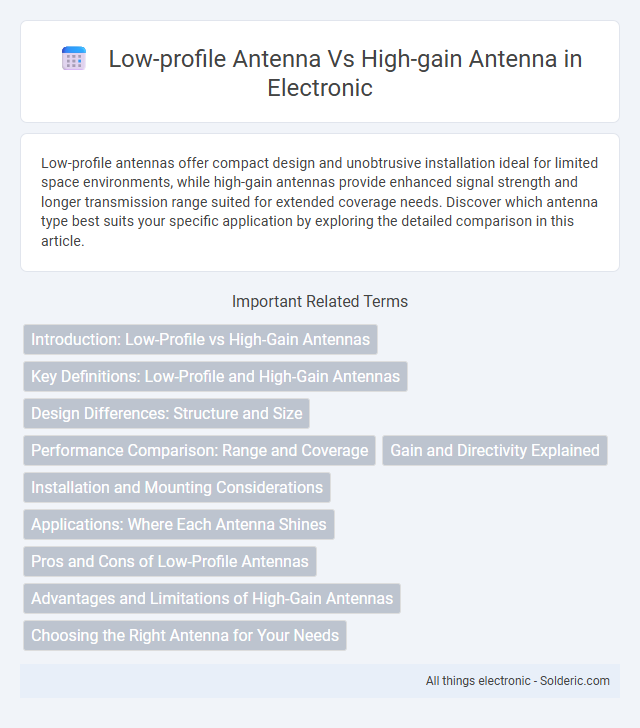Low-profile antennas offer compact design and unobtrusive installation ideal for limited space environments, while high-gain antennas provide enhanced signal strength and longer transmission range suited for extended coverage needs. Discover which antenna type best suits your specific application by exploring the detailed comparison in this article.
Comparison Table
| Feature | Low-Profile Antenna | High-Gain Antenna |
|---|---|---|
| Size | Compact, slim, minimal height | Larger, bulkier, increased height |
| Gain | Low to moderate gain (typically 2-5 dBi) | High gain (typically 8-15+ dBi) |
| Range | Short to medium range coverage | Long-range signal transmission and reception |
| Radiation Pattern | Omnidirectional or wide beamwidth | Directional or narrow beamwidth |
| Use Case | Indoor use, discreet installations, mobile devices | Outdoor use, point-to-point links, long-distance communication |
| Installation | Easy, low profile suitable for tight spaces | Requires stable mounting, alignment for directionality |
| Cost | Generally lower cost | Typically higher cost due to complexity and gain |
Introduction: Low-Profile vs High-Gain Antennas
Low-profile antennas offer compact designs with minimal visual impact, making them ideal for space-constrained environments and applications requiring discreet installation. High-gain antennas provide focused signal strength enabling extended range and improved reception, suitable for long-distance communication and high-performance wireless systems. Selecting between low-profile and high-gain antennas depends on balancing space limitations with desired signal reach and strength.
Key Definitions: Low-Profile and High-Gain Antennas
Low-profile antennas are characterized by their compact, flat design that enables discreet installation with minimal visual impact, often used in environments where space or aesthetics are critical. High-gain antennas focus on maximizing signal strength and transmission range through directional radiation patterns, making them essential for long-distance communication and enhanced signal quality. Understanding these key definitions helps in selecting the appropriate antenna type based on spatial constraints and performance requirements.
Design Differences: Structure and Size
Low-profile antennas feature compact, flat designs that prioritize minimal visibility and ease of installation, making them ideal for space-constrained or aesthetic-sensitive applications. High-gain antennas typically have larger structures with intricate elements such as parabolic dishes or arrays, which enhance signal directionality and strength but increase size and weight. The structural differences directly affect performance, with low-profile antennas excelling in portability and discreetness, while high-gain antennas deliver superior range and signal focus through their more complex and sizeable designs.
Performance Comparison: Range and Coverage
Low-profile antennas offer compact design and better aesthetics but typically provide shorter range and limited coverage compared to high-gain antennas. High-gain antennas enhance signal strength by focusing energy in specific directions, resulting in extended range and improved coverage, ideal for long-distance communication. Your choice depends on whether you prioritize discreet installation or maximized signal performance for broader area connectivity.
Gain and Directivity Explained
Low-profile antennas offer moderate gain and broader directivity, making them suitable for applications requiring wide coverage and minimal visibility. High-gain antennas, in contrast, concentrate signal energy into a narrow beam, achieving greater gain and enhanced directivity for long-distance communication or point-to-point links. Understanding your needs for signal reach and spatial focus helps determine the optimal antenna type for your system.
Installation and Mounting Considerations
Low-profile antennas offer flexible installation options due to their compact design, making them ideal for mounting on vehicles, walls, or confined spaces where aesthetics and height restrictions are critical. High-gain antennas typically require more robust mounting solutions to ensure stability, often needing elevated or unobstructed locations to maximize their directionality and signal strength. Choosing between the two depends on site constraints, with low-profile antennas favoring discreet placement and high-gain antennas demanding precise alignment and secure mounting hardware.
Applications: Where Each Antenna Shines
Low-profile antennas excel in applications requiring discreet installation and minimal visual impact, such as in urban environments, wearable devices, and unmanned aerial vehicles (UAVs). High-gain antennas are ideal for long-range communication, satellite links, and radar systems where signal strength and directionality are critical. Each antenna type serves distinct purposes based on site constraints and performance requirements.
Pros and Cons of Low-Profile Antennas
Low-profile antennas offer discreet installation with minimal visual impact and are ideal for urban environments or areas with strict aesthetic regulations. They generally provide broader coverage with moderate gain but may suffer from reduced signal strength and limited range compared to high-gain antennas. Your choice depends on balancing the need for subtle design with performance requirements in your specific application.
Advantages and Limitations of High-Gain Antennas
High-gain antennas offer focused signal transmission that significantly extends communication range and improves signal quality, making them ideal for long-distance and point-to-point applications. Their directional nature enhances signal strength but limits the coverage area and reduces performance in environments requiring broad, omni-directional coverage. Installation complexity and size also increase with higher gain, which can be a limitation in space-constrained or mobile setups.
Choosing the Right Antenna for Your Needs
Low-profile antennas offer discreet installations with moderate range and are ideal for urban or space-constrained environments. High-gain antennas provide extended range and stronger signal strength, making them suitable for long-distance communication and challenging terrains. Selecting the right antenna depends on balancing coverage requirements, physical installation constraints, and signal performance demands.
low-profile antenna vs high-gain antenna Infographic

 solderic.com
solderic.com